Anterior Knee Pain
Table of Contents
What is an Anterior Knee Pain?
Anterior knee pain, also known as patellofemoral pain syndrome, is a common condition characterized by pain and discomfort in the front of the knee. It primarily affects the area where the kneecap (patella) rests on the thigh bone (femur). This condition is often seen in physically active individuals, such as athletes or people who engage in activities that involve repetitive knee movements.
The front and center of the knee, typically beneath the patella, can occasionally hurt in an adolescent or young adult who is physically active and engages in sports. Adolescent anterior knee discomfort is a condition that frequently affects young, healthy athletes, especially girls.
Adolescent anterior knee pain is typically brought on by overuse or a training regimen that does not include enough stretching or strengthening exercises, not by a physical defect (abnormality) in the knee. The majority of the time, straightforward treatments like rest, over-the-counter drugs, and strengthening exercises will ease anterior knee pain and enable the young athlete to resume their preferred sports.
Anatomy
The largest and most powerful joint in your body is the knee. It is made up of the patella (kneecap), the upper end of the tibia, and the lower end of the femur (thighbone). Articular cartilage, a smooth, slick substance that covers the ends of the three bones that make up the knee joint, protects and cushions the bones as you bend and straighten your knee.
Ligaments join one bone to another bone. In your knee joint, there are 4 main ligaments. They function as sturdy cords to hold the bones together and maintain the stability of your knee.
Tendons join the muscles to the bones. The front thigh muscles are joined to the kneecap by the quadriceps tendon. The patellar tendon runs from the kneecap to your shinbone.
Causes of Anterior Knee Pain
It’s usually difficult to pinpoint the precise cause of anterior knee pain. Because of its intricate architecture, which enables it to flex while bearing enormous loads, the knee joint is extremely sensitive to:
- Small problems with alignment
- Activity
- Training
- Overuse
For instance, anterior knee discomfort may result from weakening in the quadriceps muscles near the front of the leg. The quadriceps muscles assist in keeping the kneecap in a groove at the end of the femur when the knee bends and straightens. Having weak quadriceps can result in the kneecap not tracking properly in the groove. This may result in tendonitis or chondromalacia patella, an irritation of the cartilage lining on the bottom of the kneecap caused by additional tension on the tendons.
Adolescent anterior knee discomfort may also result from the following other factors:
- Imbalance in the quadriceps and hamstrings, the thigh muscles that support the knee joint
- Hamstring and quadriceps muscles that are tight
- The legs’ hips and ankles not being in proper alignment
- Using ineffective methods or tools for sports training
- Footwear or playing surface modifications
- Excessive exercise or a change in the style of training
- A new sport is being started too soon, or increasing physical activity too quickly.
Symptoms of Anterior Knee Pain
The most typical sign of anterior knee discomfort is a dull, aching pain that gradually develops and is frequently triggered by activities. Other typical signs include:
knee popping or cracking as you ascend stairs or stand up and move after a lengthy period of sitting
Pain at night
Knee pain when performing repetitive knee-bending motions (such as jumping, squatting, running, and other weightlifting exercises)
Pain brought on by a modification in activity or intensity, the playing field, or equipment
The edema around the knee is typically absent in adolescents with anterior knee pain syndrome. It’s also rare to experience symptoms like clicking, locking, snapping, or the knee giving way. These signs should prompt a visit to the doctor since they point to a mechanical issue with the knee.
Diagnosis
Physical Examination
Your physician will:
To identify the source of pain behind your kneecap and rule out other issues, examine your knee. perhaps have you walk, run, jump, squat, sit, and lay down
Your doctor will also look at these things while performing the physical exam:
- Position of the kneecap and the lower leg’s alignment
- Knee stability, hip rotation, and the hips’ and knees’ range of motion
- Check the kneecap for any discomfort
- The connection between the kneecap and the thigh muscles
- Strength, range of motion, hardness, tone, and circumference of the quadriceps and hamstrings in the front and back of the thighs, respectively
- The flexibility of the feet and how tightly the heel cord is wound
Tests
X-rays. Simple X-rays can produce precise images of dense things like bone. Your doctor will be able to detect any issues with the kneecap’s position or shape using special X-ray imaging. Your doctor might order X-rays of both of your legs to check for any differences.
MRI scans, or magnetic resonance imaging. The soft tissues (including ligaments, tendons, and muscles) around your knee can be visualized better with an MRI scan than they can with an X-ray.
During the first diagnosis and workup of anterior knee discomfort, an MRI is typically not performed unless you have symptoms like locking or catching of the knee.
To determine if there is an internal issue within the knee joint, such as damage to the cartilage or ligaments, your doctor may request an MRI during a subsequent visit if your symptoms do not go away on their own or get better with treatment.
Treatment of Anterior Knee Pain
You can make some easy adjustments to ease anterior knee pain.
Medical Treatment
Nonsteroidal Anti-inflammatory Drugs (NSAIDs)
Your pain may be reduced by over-the-counter drugs like ibuprofen and naproxen. To prevent the possibility of a stomach upset as a side effect, take these medications with meals at all times. Consult your doctor for a more thorough assessment if NSAIDs do not relieve the symptoms.
Physical Therapy Exercises for Anterior Knee Pain
Gentle stretching and strengthening exercises may help ease the pain while enhancing your flexibility and range of motion if your knee pain is brought on by an injury, surgery, or arthritis.
Even though it may seem counterintuitive to exercise an injured or arthritic knee, doing so is better for your knee than sitting still. Your knee may stiffen if you don’t move it, making the pain worse.
You can strengthen the muscles that support your knee joint by gently stretching and strengthening exercises. Stronger muscles can ease the strain and impact on your knee and make it easier for your knee joint to move.
A doctor might advise imaging if your knee pain is severe to assess the damage.
Consult with a doctor or physical therapist to make sure the exercises are safe for you before beginning a program for knee pain. Depending on your circumstances, they might advise making some changes or starting an exercise regimen under the guidance of a physical therapist.
Straight leg raises
The straight leg raise tones both your hip flexor and quadriceps muscles. You should feel your shins if you flex your foot at the end of the exercise, tighten.
You can add a 5-pound ankle weight as the exercise becomes easier and progressively increase the weight as your leg strength increases.

To perform this exercise:
- You can use a mat for this exercise to add comfort under your back.
- One leg should be bent and one should be extended straight in front of you as you lay on the ground.
- Straighten your leg, flex your quadricep, and slowly lift it off the ground until it is level with your bent knee.
- After a 5-second pause, lower yourself to the starting position.
- Perform 2 to 3 sets of 10 repetitions for each leg.
Hamstring stretch
Your hamstrings, which are located in the back of your thigh, are the focus of this stretch. This stretch should feel good in the back of your leg and to the bottom of your glutes. Your calves might also feel stretched if you flex your foot.

To perform this exercise:
- You can use a mat to add comfort under your back while performing this stretch.
- Straighten both legs while lying flat on the ground or on a mat. Alternatively, if it’s more comfortable, you can stand with your feet flat on the ground and bend both knees.
- Raising one leg off the ground.
- To gently pull your knee towards your chest until you feel a gentle stretch, position your hands behind your thigh but below the knee. It shouldn’t hurt to say this.
- Hold for a few seconds.
Side leg raises
The hip abductor muscles are worked during this exercise. Your hip abductor muscles, which are on the Support effortless standing, walking, and leg rotation away from your hips. they can be treated and prevented from hurting by strengthening.
You can add a 5-pound ankle weight as the exercise becomes easier and progressively increase the weight as your strength increases.
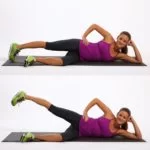
To perform this exercise:
- Your legs should be stacked on top of one another as you lay on your side. Put one hand on the Hip in front of you and cradle your head in the other.
- Lift your top leg as high as you can comfortably. At the top, pause for a moment, then lower your leg.
- Perform 2 to 3 sets of 10 repetitions for each leg.
Prone leg raises
Both your glutes and your hamstrings are worked during this exercise. You can gradually increase the weight as you get better at this exercise by starting with a 5-pound ankle weight and working your way up as your leg muscles get stronger.
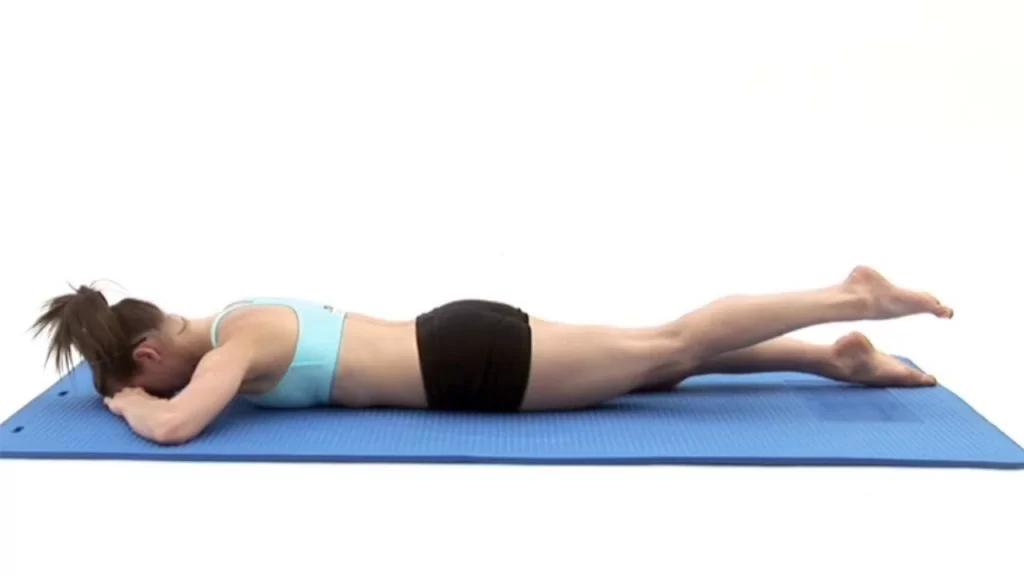
To perform this exercise:
- You can add cushioning underneath you for this exercise by using a mat.
- Lift your left leg as high as you can comfortably.
- Throughout this exercise, be sure to keep your pelvic bones on the floor. Hold your lifted leg in place for five seconds.
- Lower your leg.
- Perform 2 to 3 sets of 10 repetitions for each leg.
Leg extensions
By strengthening your quadriceps with your own body weight rather than a weighted machine, you can lessen the strain on your knees.
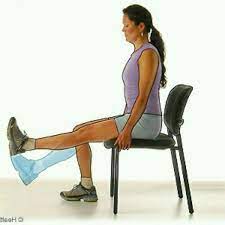
To perform this exercise:
- In your chair, sit up straight.
- Keep your feet hip-width apart on the floor.
- Lift one leg as high as you can without getting out of the chair by straightening your spine, contracting your thigh muscles, and doing so.
- After pausing, return to the initial position.
- Perform 2 to 3 sets of 10 repetitions for each leg.
Hamstring curl
Your hamstrings and glutes are the focus of the standing hamstring curl. To maintain the stability of your upper body and hips, you also need strong core muscles.
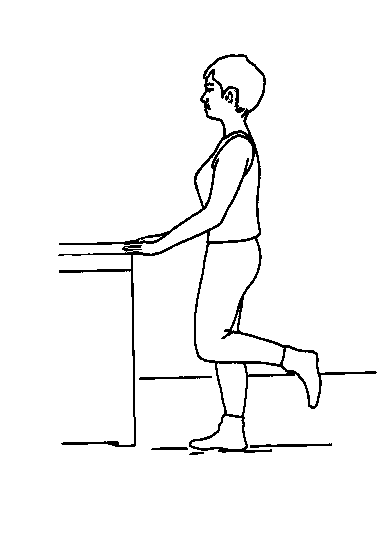
To perform this exercise:
- Use a chair or a wall as support as you stand there. Hip distance should separate your feet.
- Flex your knee, and lift your heel toward the thigh.
- Keep your upper body still and your hips pointing forward while moving as far as you can. For 5 to 10 seconds, hold.
- Return to the starting position after taking a deep breath.
- Perform 2 to 3 sets of 10 repetitions for each leg.
Calf raises
Your calf muscles, which are located on the back of your lower legs, are strengthened by this exercise.

To perform this exercise:
- Place your feet shoulder-width apart as you stand. For support, take a position next to a wall or cling to the back of a chair.
- To stand on the balls of your feet, raise both of your heels off the ground.
- Gradually return your heels to the starting position. When performing this exercise to strengthen your calf muscles, control is key.
- Make an effort to complete two or three sets of ten repetitions.
Half squat
A great exercise for strengthening your quadriceps, glutes, and hamstrings without putting too much strain on your knees is the half squat.
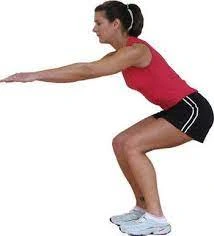
To perform this exercise:
- Standing with your feet shoulder-width apart, squat down. For balance, put your hands on your hips or in front of you.
- Slowly lower yourself by about 10 inches while keeping your head straight. The distance from here to a full squat is halfway. After a brief pause, push through your heels to stand up.
- Try to complete two or three sets of ten repetitions.
Quadriceps stretch
The focus of this stretch is on your quadriceps, which are found in the front of your thighs. If you do this exercise, your quadriceps and hip flexors will become more flexible.
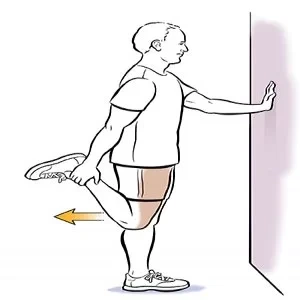
To perform this exercise:
- Use a chair or a wall as support as you stand. Your feet should be separated by shoulder width. Your Flexing one knee should cause the foot to rise up towards your glutes.
- As far as you can comfortably do so, gently pull your ankle towards your glutes while holding onto it.
- Hold for a minute.
- Change legs, then go back to the starting position.
- On each side, repeat twice.
Heel and calf stretch
Your lower leg muscles, more specifically your calf muscles, are the focus of this stretch.

To perform this exercise:
- Position yourself so that you are facing a wall.
- Put your hands on the wall and step back as far as you can without feeling uncomfortable. Both feet should have their toes pointed forward, the heels should be flat, and your knees should be slightly bent.
- Hold the stretch for 30 seconds while leaning into it. Your back leg ought to feel stretched. Repeat while changing legs.
- On each leg, repeat this stretch twice.
Surgical Treatment
The surgeon opens the knee structure through a slightly larger incision, and the lateral release technique is then used to realign the kneecap. To restore the patella’s normal position and tracking, the tight lateral ligaments must be cut.
Orthotics and Footwear
Shoe inserts may be suggested by your doctor. Soft, firm, and hard-molded arch supports can ease pain and fatigue by preventing overpronation, which occurs when the arches of your feet flatten more than they should. You can get several arches supports from your neighborhood pharmacy.
Make sure your running shoes offer the appropriate support for your activities. and are the proper dimensions. Replace your sporting shoes as soon as they become worn out or damaged.
Activity Changes
Once the pain is fully gone, stop doing the things that affected your knee. This most likely requires altering your exercise regimen. You can reduce the strain on your knee joint during this time by switching to low-impact activities. Yoga, swimming, and biking are all suitable low-impact activities.
Restart running and other high-impact sports gradually after the pain has subsided.
Losing weight will also aid in relieving pressure on your knee if you are overweight.
Your exercise method can be the cause of your knee pain. You might be able to assess and enhance some aspects of your technique, including how you land after a jump or push-off from the starting line, with the aid of a trainer at school.
Your repeated use of the same activity or training exercise can lead to a thigh muscle imbalance that is the cause of your knee pain. This indicates that one muscle is more powerful than the others. Cross-training may be suggested by your physician or fitness professional to strengthen the weaker muscle (usually the quadriceps or hamstrings).
You could treat your knee pain by simply adding stretches to your routine if it’s caused by tight muscles.
Recovery
Adolescent anterior knee discomfort is typically completely treated by straightforward methods. If you do not alter your exercise regimen or activity level, it can return. Maintaining proper conditioning of the knee-supporting muscles, particularly the quadriceps, and hamstrings, is crucial.
There are extra actions you can do to stop the recurrence of anterior knee discomfort. They consist of:
Choosing footwear based on your activities
Before engaging in physical exercise, properly warming up
Stretching both before and after physical activity, as well as throughout your warm-up routine
Limiting any activity that has previously caused damage to your knees
Reducing the overall distance you run for both training and competition
Using different exercises to prevent overusing one muscle group or joint
Summary
A person with anterior knee pain feels pain behind or around the kneecap. It frequently happens as a result of anatomical anomalies, excessive use or activity, muscular imbalances, or knee problems.
A doctor can identify the causes and provide the best knee treatment with the aid of a thorough medical history, physical examination, and imaging tests.
A person can manage anterior knee discomfort by altering their lifestyle, such as by keeping a healthy weight, selecting footwear that fits properly, and avoiding activities that make the pain worse.
Usually, symptoms become better in a couple of weeks. Long-term knee pain sufferers should see a doctor for an evaluation, a proper course of therapy, and a rehabilitation program.
FAQs
Should you walk while experiencing anterior knee pain?
Any action that makes your symptoms worse should be avoided. By applying an ice pack, resting your leg, and taking anti-inflammatory pain relievers like ibuprofen, you may be able to reduce your pain. Exercises that strengthen the muscles around your kneecap may also be beneficial.
What might be a factor in anterior knee pain?
When the kneecap does not move freely and bumps into the bottom portion of the thigh bone, anterior knee pain develops. This could happen because The patellofemoral joint is not properly aligned, which is another name for the kneecap’s aberrant location. The muscles on the front and rear of your thigh are tight or weak.
What type of exercise should someone who has anterior knee soreness avoid?
Localized to the front of the knee, the symptoms are frequently made worse by squatting, climbing and descending stairs, or high-impact workouts like sprinting and leaping.
How long does discomfort in the anterior knee last?
The reason for the anterior knee pain affects how long it takes to heal. But symptoms usually go away after a few weeks. In rare circumstances, it’s possible for some athletes’ problems to completely disappear after 2 years. Physical therapy or rehabilitation may be recommended by doctors to their patients.

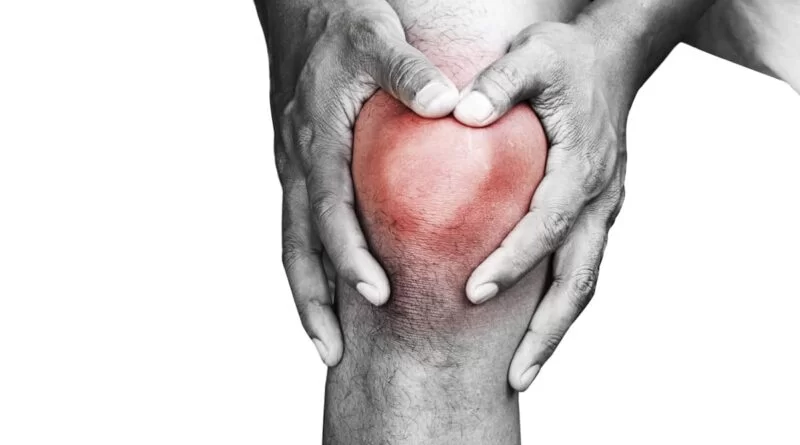
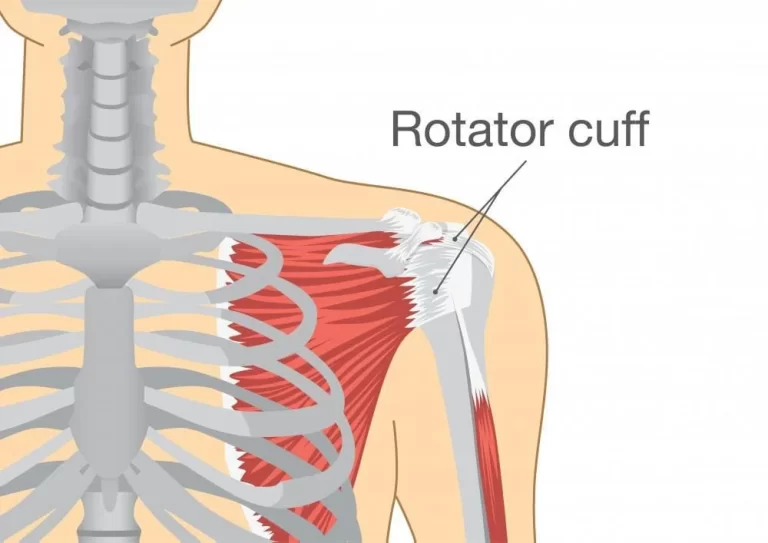
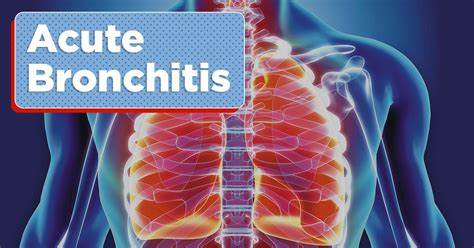

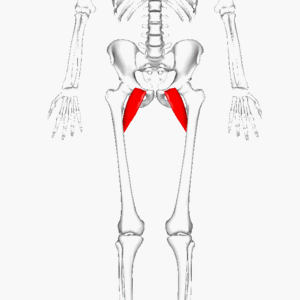
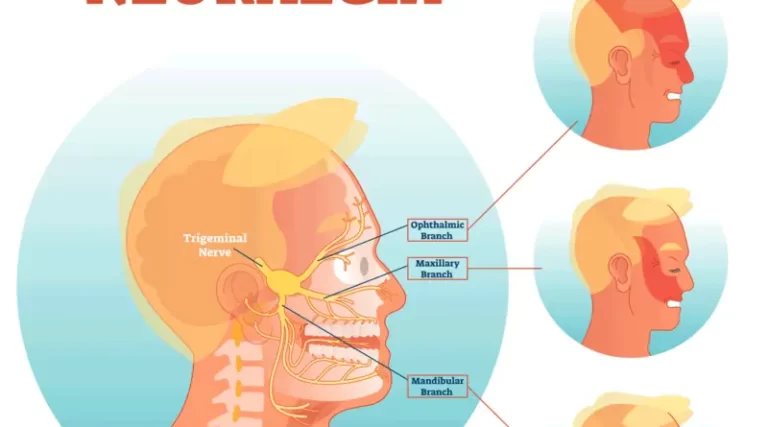
3 Comments